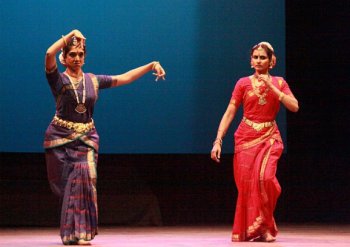
|   |

|   |
Abbakka Rani - Probal Gupta, Bangalore e-mail: probs_gupta12@yahoo.co.in January 6, 2011 In the 16th century, a queen called Abbakka ruled from Moodabidri and used Ullal as her financial capital. Born in the matrilineal line of Chowtas, Abbakka was a brilliant queen who excelled in governance, administration, warfare and above all, patriotism. Tutored by her uncle Tirumala Raya, Abbakka became a fearless wielder of the sword, spear and bow. She also mastered diplomacy and war strategy and tactics. Abbakka developed a strong land and naval force and kept the colonizing Portuguese at bay for over four decades. Guru Usha Venkateshwaran used the patriotic story of Abbakka to manifest through a brilliant choreographic work using Bharatanatyam, Kalarippayattu, Kathak, martial arts, Bhootkola - a folk form from the Pulanadu district of Mangalore including glimpses of gypsy dance and multimedia. However, all the art forms blended beautifully and aesthetically on the platform of dance to be called "extravagant." Devoid of sahitya, one must congratulate Usha for brilliantly using instrumental music effectively to bring out the desired rasa to the connoisseurs.
Amongst the minor roles, Nishanth Arvindakshan's roles as Durga Prasad (the fort keeper), or perhaps even as a boatman, or the soldiers getting trained for the battle along with Abbakka in Kalarippayattu deserves special mention. A professional visual artist and also trained in Bharatanatyam, the dancer actor vehemently uses his mastery over fine arts and that shows aesthetically in his dance too. Dance being an audio visual art form, one must congratulate him for exaggerating a minor role into a dimension that lingers in an aficionado's mind. Clear movements, good postures during the Kalarippayattu sequence, remarkable internalization of abhinaya vibrates through the rasika's mind. Deepa Shivananda excelled in the role of Lakshmanappa's sister Sita, a patriotic character. Especially the seductive sequence, perhaps the most challenging amongst the rasas and an incongruous element of shringara - the sambhoga deserves special mention. Abhinaya reaches the climax when an actor conveys it aesthetically to the rasikas. Deepa's mellifluous abhinaya, neat charis, demanding stage presence, suitable colours of the costume with her skin texture, swift drift onto the floor of the proscenium as if being pushed behind the bars was noteworthy. Usage of multimedia effectively with the boats being fired by throwing of coconut shells by the people of Abbakka with Prasanna, Pawan, Nishant carrying small deepams as a metaphor of tiny boats with typical movements deserves applause.   Prasanna Kumar as a Maulvi excelled in a short spanned solo sequence. Trained in Bharatanatyam under the Late Padmini Rao and presently under veteran Guru Sudharani Raghupati, one must appreciate the internalization of abhinaya the dancer has mastered with assiduous effort. It was a short piece, yet the momentum with which the execution of the scene was carried out by Prasanna as a Maulvi sitting inside a mosque reading Quran and praying to Allah, the background music concomitant to a Muslim musical score with an enhancement of the plot being made obvious with the interior of a mosque and the correct usage of multimedia, aggrandized the overall effect. Prasanna's role over here is crucial which the choreographer brilliantly used to showcase unity amongst religions where a Maulvi safeguards the protagonist, thereby protecting his country. Rupesh excelled in his role as a cruel Portuguese, with his slightly heavier body structure and curly hair, the face screwed brilliantly while plotting to invoke all miscreant activities in Lakshmanappa. The role of Aparna well suited in the gypsy dancing while Pawan Kumar's role was apt with his characterization of the general. The drama concluded with Lakshmanappa visiting the captives in prison and taunting his wife. He demands her obedience. Abbakka feigns confusion and requests him time to think things over. Later that night, the queen and her daughters (Savitha Josephine, Aarti Mohar) rouse the feelings of freedom in the souls of other prisoners. They organize an attack to either gain freedom or die with honor. Armed with whatever they can find, the inmates led by the queen attack the guards. Alarmed at this uprising, the guards shoot all of them dead leaving one of the daughters of Abbakka (Aarti) alive through whom the spirit of patriotism dwells. The finale came with our enchanting national anthem "Jana Gana" surging a poignant feeling of patriotism. Probal Gupta trained in Kathakali under two legends Late Kalamandalam Govindan Kutty and Guru Fact Padmanabhan under whom he is presently continuing his specialization in Stree Vesham genre of Kathakali. He has also been a student of Bharati Shivaji. He is an empanelled artist of Doordarshan and has established a Solo Margam for Stree Vesham Kathakali under the able guidance of his Guru Fact Padmanabhan. Probal is a graduate in English Hons from the University of Kolkata. He writes for the Bangalore edition of The Hindu. |